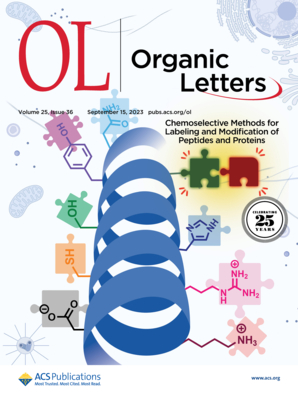硼基自由基介导的烯烃与位阻NHC硼烷的氢-二硼基烷基化反应
IF 5
1区 化学
Q1 CHEMISTRY, ORGANIC
引用次数: 0
摘要
NHC硼基自由基介导的卤素原子转移(XAT)在有机合成中有广泛的应用。然而,大多数反应只以卤素还原成氢结束,也就是说,碳- x还原成碳氢。这在缺电子的烷基卤化物中尤其明显,形成的亲电自由基与NHC硼烷反应迅速。本文采用位阻NHC硼烷作为硼基前体(IPr·BH3),在C-C键形成反应中使用了亲电性不足的烷基卤化物(α-碘化物gem-di(B(pin))methane)。用单取代苯乙烯、二取代苯乙烯、脂肪烯烃和杂原子取代烯烃作为反应伙伴。在室温下以中高收率得到了40个氢(宝石-二硼基)甲基化产物。详细的机理研究表明,该反应主要涉及自由基过程。本文章由计算机程序翻译,如有差异,请以英文原文为准。

Boryl Radical Mediated Hydro(gem-diboryl)alkylation of Alkenes with Sterically Hindered NHC Boranes
NHC boryl radical mediated halogen atom transfer (XAT) is useful in organic synthesis. Yet, most of the reaction ends only with reducing the halogen to hydrogen, that is, the C–X to C–H. This is especially dominant for electron-deficient alkyl halides, where the formed electrophilic radical reacts rapidly with NHC boranes. Herein, by employing a sterically hindered NHC borane as the boryl radical precursor (IPr·BH3), we were able to use the electrophilic-deficient alkyl halide (α-Iodide gem-di(B(pin))methane) in the C–C bond formation reaction. Mono-, disubstituted styrene, aliphatic alkenes, and heteroatom-substituted alkenes were used as reaction partners. Forty hydro(gem-diboryl)methylation products were obtained at room temperature in moderate to good yields. Detailed mechanistic studies revealed that the reaction mainly involved the radical process.
求助全文
通过发布文献求助,成功后即可免费获取论文全文。
去求助
来源期刊

Organic Letters
化学-有机化学
CiteScore
9.30
自引率
11.50%
发文量
1607
审稿时长
1.5 months
期刊介绍:
Organic Letters invites original reports of fundamental research in all branches of the theory and practice of organic, physical organic, organometallic,medicinal, and bioorganic chemistry. Organic Letters provides rapid disclosure of the key elements of significant studies that are of interest to a large portion of the organic community. In selecting manuscripts for publication, the Editors place emphasis on the originality, quality and wide interest of the work. Authors should provide enough background information to place the new disclosure in context and to justify the rapid publication format. Back-to-back Letters will be considered. Full details should be reserved for an Article, which should appear in due course.
 求助内容:
求助内容: 应助结果提醒方式:
应助结果提醒方式:


